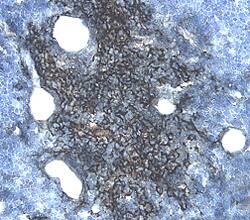Mouse DR3/TNFRSF25 Antibody
R&D Systems, part of Bio-Techne | Catalog # AF2437


Key Product Details
Species Reactivity
Validated:
Cited:
Applications
Validated:
Cited:
Label
Antibody Source
Product Specifications
Immunogen
Gln31-Phe199
Accession # AAK11256
Specificity
Clonality
Host
Isotype
Scientific Data Images for Mouse DR3/TNFRSF25 Antibody
DR3/TNFRSF25 in Mouse Thymus.
DR3/TNFRSF25 was detected in perfusion fixed frozen sections of mouse thymus using 5 µg/mL Goat Anti-Mouse DR3/TNFRSF25 Antigen Affinity-purified Polyclonal Antibody (Catalog # AF2437) overnight at 4 °C. Tissue was stained with the Anti-Goat HRP-DAB Cell & Tissue Staining Kit (brown; Catalog # CTS008) and counterstained with hematoxylin (blue). View our protocol for Chromogenic IHC Staining of Frozen Tissue Sections.Applications for Mouse DR3/TNFRSF25 Antibody
Immunohistochemistry
Sample: Perfusion fixed frozen sections of mouse thymus
Western Blot
Sample: Recombinant Mouse DR3/TNFRSF25 Fc Chimera (Catalog # 2437-D3)
Formulation, Preparation, and Storage
Purification
Reconstitution
Formulation
Shipping
Stability & Storage
- 12 months from date of receipt, -20 to -70 °C as supplied.
- 1 month, 2 to 8 °C under sterile conditions after reconstitution.
- 6 months, -20 to -70 °C under sterile conditions after reconstitution.
Background: DR3/TNFRSF25
Death receptor 3 (DR3), also known as TNFRSF25, LARD, WSL-1, APO3, TRAMP, and TR3, is a 55 kDa TNF receptor superfamily protein that is predominantly expressed by lymphocytes. TNF receptor superfamily members have varying numbers of extracellular cysteine-rich domains (CRDs) with conserved cysteine spacing (1, 2). DR3 contains four CRDs and one cytoplasmic death domain (3, 4). Alternative splicing of mouse DR3 generates an isoform that lacks the fourth CRD and a secreted isoform that consisits of only the extracellular domain (ECD) (3). Human DR3 exists in at least eleven alternate splice forms (5). Within the ECD, mouse and human DR3 share 59% amino acid (aa) sequence identity. DR3 shares 20-28% aa sequence identity with the ECD of death domain receptors DR5, DR6, EDAR, Fas, NGF R, and TNF RI. Naïve B and T cells preferentially express truncated soluble isoforms of DR3, whereas stimulated lymphocytes preferentially express transmembrane DR3 (5). TL1A/TNFSF15, a high affinity DR3 ligand which also exists in membrane bound and soluble forms, is expressed by activated endothelial cells and T cells (6, 7). TL1A additionally binds to DcR3/TNFRSF6B, a soluble decoy receptor that interferes with DR3 activation (8). DR3 signaling triggers either apoptosis or NF kappaB-induced anti-apoptotic effects depending on the cellular setting (9). Apoptosis is partially impaired during negative selection of thymocytes in DR3-null mice (10). TL1A interactions with DR3 augment T cell proliferation and pro‑inflammatory cytokine secretion (6, 7, 11, 12). DR3 is upregulated by inflammatory stimulation of CCR9+ T cells, a T cell subset important in mucosal immunity (11). T cell and macrophage DR3 expression is prominent in several inflammatory disorders such as Crohn’s disease, inflammatory bowel disease, and atherosclerosis (7, 11-15). DR3 activation on IFN-gamma treated THP-1 cells induces the production of TNF‑ alpha, CXCL8, CCL2, MMP-1, -9, and -13 (14, 15).
References
- Fas, S.C. et al. (2006) Curr. Dir. Autoimmun. 9:1.
- Aggarwal, B.B. (2003) Nat. Rev. Immunol. 3:745.
- Wang, E.C.Y. et al. (2001) Immunogenetics 53:59.
- Borysenko, C.W. et al. (2005) Biochem. Biophys. Res. Commun. 328:794.
- Screaton, G.R. et al. (1997) Proc. Natl. Acad. Sci. USA 94:4615.
- Migone, T.S. et al. (2002) Immunity 16:479.
- Prehn, J.L. et al. (2004) Clin. Immunol. 112:66.
- Yang, C-R. et al. (2004) Cancer Res. 64:1122.
- Wen, L. et al. (2003) J. Biol. Chem. 278:39251.
- Wang, E.C.Y. et al. (2001) Mol. Cell. Biol. 21:3451.
- Papadakis, K.A. et al. (2005) J. Immunol. 174:4985.
- Papadakis, K.A. et al. (2004) J. Immunol. 172:7002.
- Bamias, G. et al. (2003) J. Immunol. 171:4868.
- Kim, S-H. et al. (2001) Jpn. Circ. J. 65:136.
- Kang, Y-J. et al. (2005) Cytokine 29:229.
Long Name
Alternate Names
Gene Symbol
UniProt
Additional DR3/TNFRSF25 Products
Product Documents for Mouse DR3/TNFRSF25 Antibody
Product Specific Notices for Mouse DR3/TNFRSF25 Antibody
For research use only